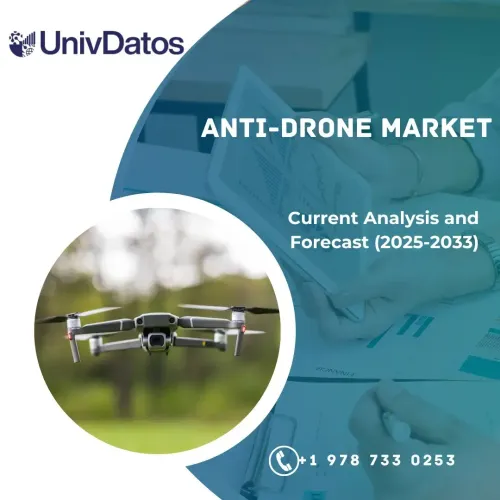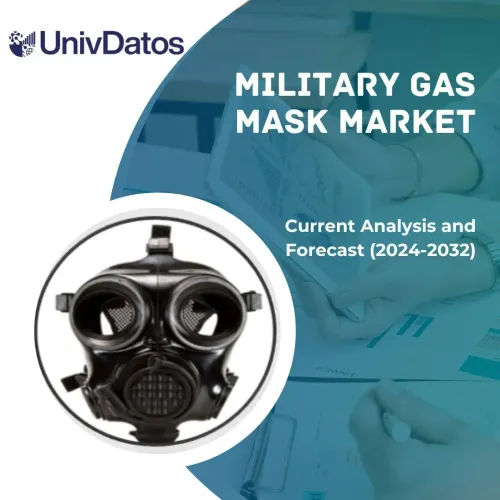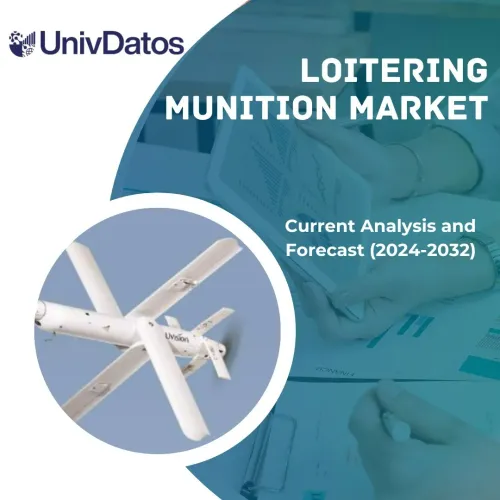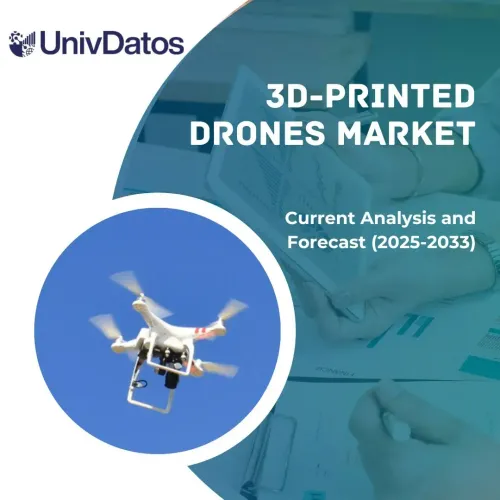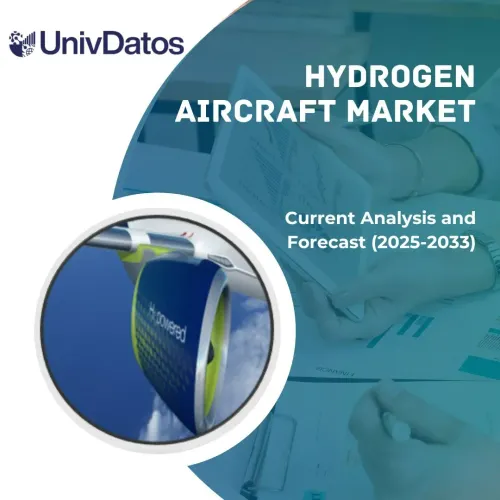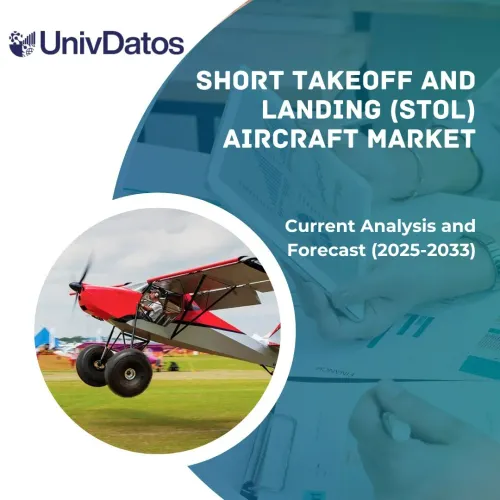- Inicio
- Acerca de nosotros
- Industria
- Servicios
- Leyendo
- Contáctenos
Mercado de Guerra con Drones: Análisis Actual y Pronóstico (2024-2032)
Énfasis en la Capacidad (Plataforma, Servicios, Software, Estaciones de Control Terrestre y Sistema de Lanzamiento y Recuperación de Drones); Modo de Transporte (Semiautónomo y Autónomo); Aplicación (Combate, Entrega y Transporte, Inteligencia, Vigilancia y Reconocimiento, y Otros); y Región/País
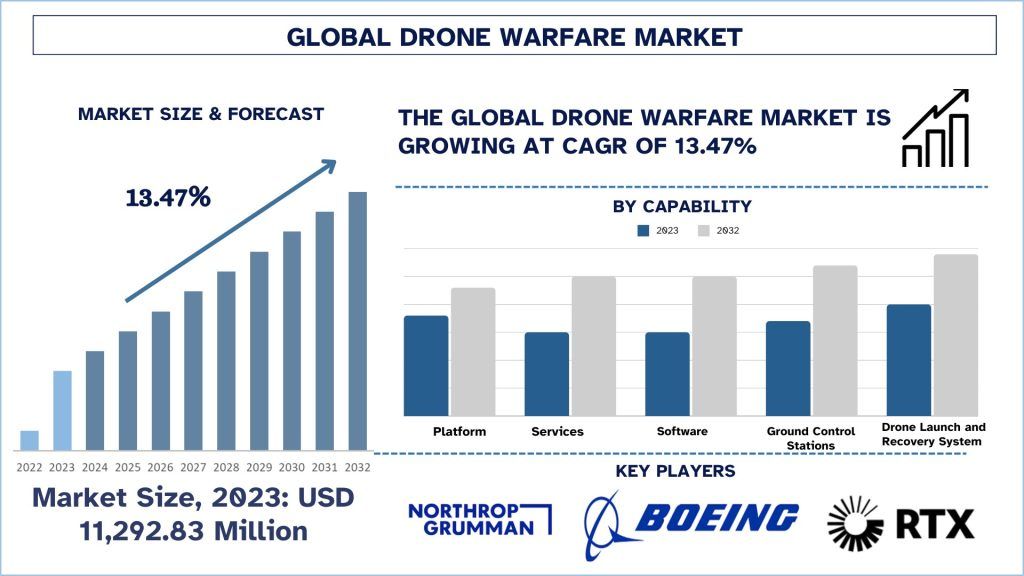 Tamaño y Pronóstico del Mercado de Guerra con Drones
Tamaño y Pronóstico del Mercado de Guerra con Drones
El mercado de guerra con drones se valoró en USD 11,292.83 millones en 2023 y se espera que crezca a una robusta CAGR de alrededor del 13.47% durante el período de pronóstico (2024-2032). Debido al aumento del uso de drones en seguridad y vigilancia y las crecientes tensiones geopolíticas.
Análisis del Mercado de Guerra con Drones
El mercado de guerra con drones ha surgido rápidamente en los últimos años debido a las innovaciones tecnológicas y el creciente uso de drones militares en diferentes campos. El mercado está altamente insaturado con drones que van desde pequeños drones discretos hasta drones grandes y altamente diseñados para usos militares. Debido a los avances tecnológicos en inteligencia artificial, aprendizaje automático y sensores, la capacidad de los drones ha mejorado en términos de eficiencia, auto-ejecución y aplicación. Se prevé que un mayor crecimiento en este mercado se mantenga constante debido a un enfoque creciente en iniciativas de investigación y desarrollo, junto con la expansión de la penetración de los drones en las operaciones estándar. La adopción generalizada de la tecnología de drones tiene profundas implicaciones para varios sectores. En el sector de la defensa, los drones proporcionan capacidades críticas para la vigilancia, el reconocimiento y las operaciones dirigidas, mejorando la seguridad nacional. Por ejemplo, en marzo de 2024, Taiwán adquirió cuatro drones MQ-9B SkyGuardian adicionales de EE. UU. para reforzar sus capacidades de vigilancia y reconocimiento. General Atomics recibió alrededor de USD 250 millones para entregar los sistemas no tripulados, junto con dos estaciones de control terrestre certificables, repuestos y equipos de soporte necesarios.
Tendencias del Mercado de Guerra con Drones
Tecnología de Enjambre y Operaciones Colaborativas con Drones
La tecnología de enjambre y las operaciones colaborativas con drones son una tendencia emergente en la guerra con drones, que involucra a múltiples drones trabajando juntos como una unidad coordinada. Este enfoque ofrece una mayor efectividad de la misión, resistencia contra contramedidas y el potencial de abrumar las defensas, a menudo a un costo menor que los drones individuales de alta gama. Varios países como China, Estados Unidos, Turquía, Rusia e Israel han demostrado capacidades de enjambre. Por ejemplo, en 2024, investigadores chinos han anunciado la creación de un innovador dron de combate, presentando un nuevo paradigma en la tecnología de guerra. Además, Estados Unidos, a través del programa OFFSET de DARPA, ha estado trabajando en enjambres de 250 o más drones para escenarios de combate urbano desde 2017, y los drones Kargu-2 de Turquía, supuestamente utilizados en Libia en 2020, pueden operar en enjambres para atacar objetivos. A medida que esta tecnología madura, es probable que desempeñe un papel cada vez más importante en futuros conflictos.
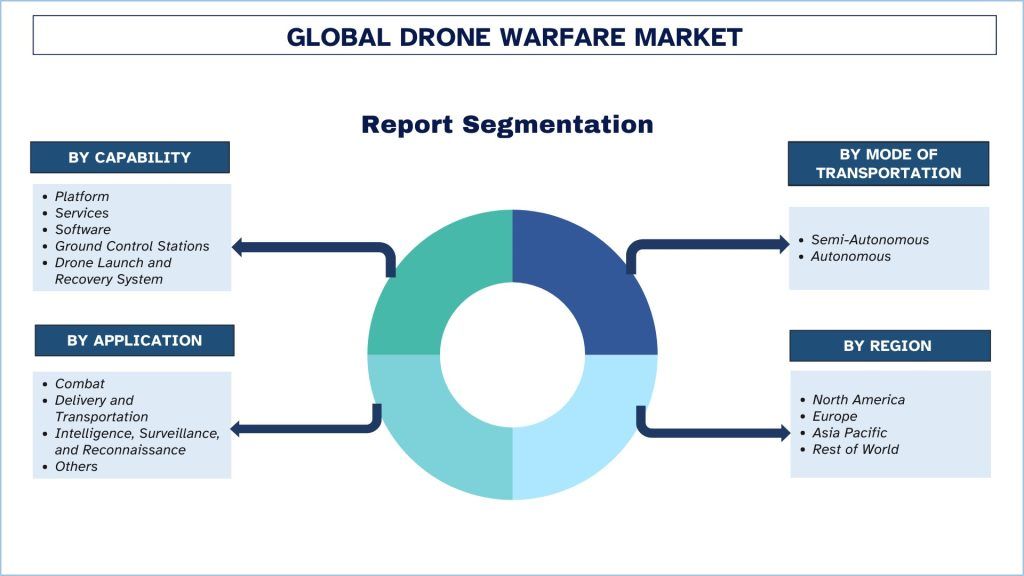
Norteamérica Dominó el Mercado de Guerra con Drones
El mercado de guerra con drones de América del Norte domina actualmente y se espera que domine en el período previsto. La industria de la guerra con drones en América del Norte, especialmente en Estados Unidos y Canadá, está creciendo rápidamente debido a los crecientes avances tecnológicos en los drones. América del Norte es el hogar de los mayores fabricantes de drones del mundo, especializados en la fabricación de drones militares. Empresas como Northrop Grumman, General Atomics, BAE Systems y otras han invertido fuertemente en drones militares. Además, los gobiernos de la región están promoviendo políticas favorables para el despliegue de drones militares para salvaguardar sus fronteras. Además, la colaboración entre empresas y gobiernos está acelerando la innovación en el mercado de drones militares en la región. Además, el aumento del presupuesto de defensa en la región ha crecido, lo que lleva a asignar fondos sustanciales en el espacio de los drones que mejora la vigilancia y el reconocimiento.
Por ejemplo, en septiembre de 2022, Lockheed Martin invirtió USD 100 millones de su propio dinero para desarrollar una sofisticada capacidad de equipo tripulado-no tripulado que involucra aviones de combate F-35 y drones de combate.
Con la colaboración de Scaled Composites, una subsidiaria de Northrop Grumman, Northrop Grumman ha presentado un dron híbrido eléctrico para misiones de aviación militar. El dron está marcado como un paso para tecnologías de aviación más sostenibles en defensa. Los drones híbridos eléctricos tienen como objetivo ofrecer mayor resistencia y flexibilidad operativa para el Departamento de Defensa.
Visión General de la Industria de la Guerra con Drones
El mercado de guerra con drones es competitivo y concentrado, con pocos actores globales e internacionales. Los actores clave están adoptando diferentes estrategias de crecimiento para mejorar su presencia en el mercado, como asociaciones, acuerdos, colaboraciones, lanzamientos de nuevos productos, expansiones geográficas y fusiones y adquisiciones. Algunos de los principales actores que operan en el mercado son Northrop Grumman Corporation, Boeing, Raytheon Technologies Corporation, Israel Aerospace Industries Ltd., General Atomics, Teledyne FLIR LLC, Airbus SE, Lockheed Martin Corporation, BAE Systems y Elbit Systems Ltd.
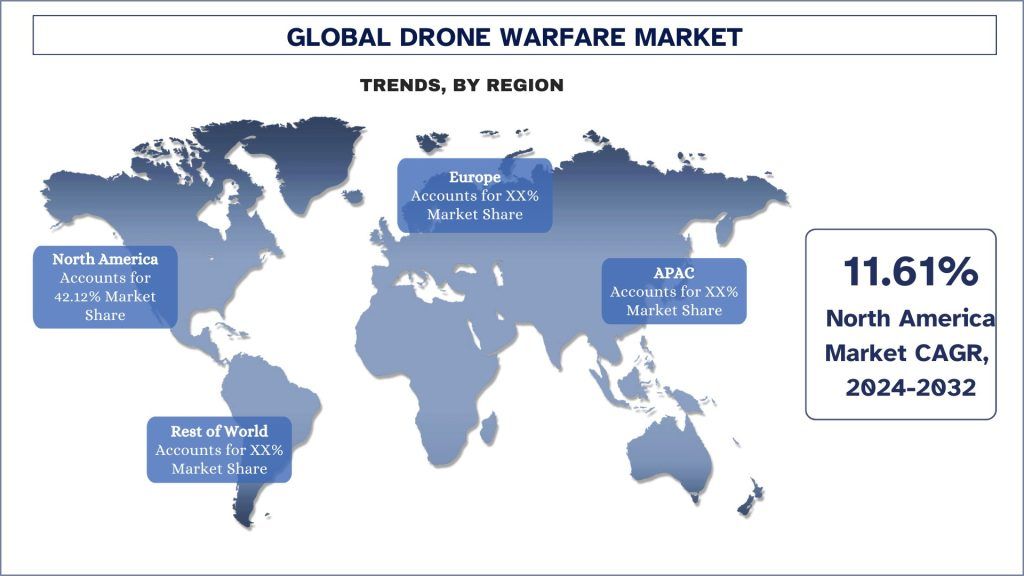
Noticias del Mercado de Guerra con Drones
En junio de 2023, General Atomics presentó el MQ-9B SkyGuardian, equipado con capacidades de combate avanzadas, incluyendo municiones guiadas de precisión y sistemas de orientación impulsados por IA para una mayor efectividad operativa.
En 2023, Northrop Grumman logró mostrar las funciones del nuevo vehículo aéreo de combate no tripulado (UCAV) X-47B con sistemas de orientación inteligentes impulsados por IA y control de vuelo habilitado para IA. Esta demostración demostró que los sistemas no tripulados podrían realizar eficazmente operaciones peligrosas con una interferencia limitada de los humanos.
En 2024, la policía de Telangana desplegará drones de vigilancia de alta gama en las regiones fronterizas del estado como parte de su esfuerzo por aumentar la seguridad en áreas afectadas por insurgencias. Estos drones avanzados se utilizaron principalmente en la Línea de Control (LOC) y la Línea de Control Real (LAC). Los drones pueden cubrir un área con un radio de 25 km y están equipados con capacidades de visión nocturna.
En mayo de 2023, Airbus Defence and Space realizó con éxito las pruebas de vuelo del Eurodrone, un UAV MALE desarrollado para realizar operaciones ISR. Este desarrollo es un logro pionero en Europa en términos de tecnología de defensa y puede demostrar las capacidades de los UAV militares nacionales.
Cobertura del Informe del Mercado de Guerra con Drones
Atributo del Informee | Detalles |
Año base | 2023 |
Período de pronóstico | 2024-2032 |
Impulso de crecimiento | Acelerar a una CAGR del 13.47% |
Tamaño del mercado 2023 | USD 11,292.83 millones |
Análisis regional | Norteamérica, Europa, APAC, Resto del mundo |
Región principal contribuyente | Norteamérica dominó el mercado en 2023 |
Países clave cubiertos | EE. UU., Canadá, Alemania, Reino Unido, España, Italia, Francia, China, Japón e India |
Empresas perfiladas | Northrop Grumman Corporation, Boeing, Raytheon Technologies Corporation, Israel Aerospace Industries Ltd., General Atomics, Teledyne FLIR LLC, Airbus SE, Lockheed Martin Corporation, BAE Systems y Elbit Systems Ltd. |
Alcance del informe | Tendencias, Impulsores y Restricciones del Mercado; Estimación y Pronóstico de Ingresos; Análisis de Segmentación; Análisis del Lado de la Demanda y la Oferta; Panorama Competitivo; Perfiles de la Empresa |
Segmentos cubiertos | Por Capacidad, Por Modo de Transporte, Por Aplicación y Por Región/País |
Razones para comprar este informe:
- El estudio incluye análisis de dimensionamiento y pronóstico del mercado validados por expertos clave de la industria autenticados.
- El informe presenta una revisión rápida del rendimiento general de la industria de un vistazo.
- El informe cubre un análisis en profundidad de los pares de la industria prominentes con un enfoque principal en las finanzas comerciales clave, las carteras de productos, las estrategias de expansión y los desarrollos recientes.
- Examen detallado de los impulsores, las restricciones, las tendencias clave y las oportunidades que prevalecen en la industria.
El estudio cubre exhaustivamente el mercado en diferentes segmentos.
- Análisis a nivel regional en profundidad de la industria.
Opciones de Personalización:
El mercado global de guerra con drones se puede personalizar aún más según el requisito o cualquier otro segmento del mercado. Además de esto, UMI comprende que puede tener sus propias necesidades comerciales, por lo tanto, no dude en contactarnos para obtener un informe que se adapte completamente a sus requisitos.
Tabla de contenido
Metodología de Investigación para el Análisis del Mercado de Guerra con Drones (2024-2032)
Analizar el mercado histórico, estimar el mercado actual y pronosticar el mercado futuro del mercado global de guerra con drones fueron los tres pasos principales realizados para crear y analizar la adopción de la guerra con drones en las principales regiones a nivel mundial. Se realizó una extensa investigación secundaria para recopilar las cifras históricas del mercado y estimar el tamaño actual del mercado. En segundo lugar, para validar estos conocimientos, se tomaron en consideración numerosos hallazgos y supuestos. Además, también se realizaron exhaustivas entrevistas primarias con expertos de la industria en toda la cadena de valor del mercado global de guerra con drones. Después de la asunción y validación de las cifras del mercado a través de entrevistas primarias, empleamos un enfoque de arriba hacia abajo/abajo hacia arriba para pronosticar el tamaño completo del mercado. Posteriormente, se adoptaron métodos de desglose del mercado y triangulación de datos para estimar y analizar el tamaño del mercado de segmentos y subsegmentos de la industria a la que pertenece. La metodología detallada se explica a continuación:
Análisis del Tamaño Histórico del Mercado
Paso 1: Estudio Profundo de Fuentes Secundarias:
Se realizó un estudio secundario detallado para obtener el tamaño histórico del mercado de guerra con drones a través de fuentes internas de la empresa, comoinformes anuales y estados financieros, presentaciones de rendimiento, comunicados de prensa, etc.y fuentes externas que incluyenrevistas, noticias y artículos, publicaciones gubernamentales, publicaciones de la competencia, informes sectoriales, bases de datos de terceros y otras publicaciones creíbles.
Paso 2: Segmentación del Mercado:
Después de obtener el tamaño histórico del mercado de guerra con drones, realizamos un análisis secundario detallado para recopilar información y participación histórica del mercado para diferentes segmentos y subsegmentos para las principales regiones. Los principales segmentos incluidos en el informe son la capacidad, el modo de transporte y la aplicación. Se realizaron análisis adicionales a nivel de país para evaluar la adopción general de modelos de prueba en esa región.
Paso 3: Análisis de Factores:
Después de adquirir el tamaño histórico del mercado de diferentes segmentos y subsegmentos, realizamos unanálisis de factoresdetallado para estimar el tamaño actual del mercado de guerra con drones. Además, realizamos un análisis de factores utilizando variables dependientes e independientes, como la capacidad, el modo de transporte y la aplicación del mercado de guerra con drones. Se llevó a cabo un análisis exhaustivo de los escenarios de la oferta y la demanda, considerando las principales asociaciones, fusiones y adquisiciones, la expansión comercial y los lanzamientos de productos en el sector del mercado de guerra con drones en todo el mundo.
Estimación y Pronóstico del Tamaño Actual del Mercado
Dimensionamiento del Mercado Actual:Basándonos en los conocimientos prácticos de los 3 pasos anteriores, llegamos al tamaño actual del mercado, a los actores clave en el mercado global de guerra con drones y a las cuotas de mercado de los segmentos. Todas las divisiones de cuotas porcentuales requeridas y los desgloses del mercado se determinaron utilizando el enfoque secundario mencionado anteriormente y se verificaron a través de entrevistas primarias.
Estimación y Pronóstico:Para la estimación y el pronóstico del mercado, se asignaron pesos a diferentes factores, incluidos los impulsores y las tendencias, las restricciones y las oportunidades disponibles para las partes interesadas. Después de analizar estos factores, se aplicaron técnicas de pronóstico relevantes, es decir, el enfoque de arriba hacia abajo/abajo hacia arriba, para llegar al pronóstico del mercado para 2032 para diferentes segmentos y subsegmentos en los principales mercados a nivel mundial. La metodología de investigación adoptada para estimar el tamaño del mercado abarca:
- El tamaño del mercado de la industria, en términos de ingresos (USD) y la tasa de adopción del mercado de guerra con drones en los principales mercados a nivel nacional
- Todas las cuotas porcentuales, divisiones y desgloses de los segmentos y subsegmentos del mercado
- Actores clave en el mercado global de guerra con drones en términos de productos ofrecidos. Además, las estrategias de crecimiento adoptadas por estos actores para competir en el mercado de rápido crecimiento.
Validación del Tamaño y la Participación de Mercado
Investigación Primaria:Se realizaron entrevistas en profundidad con los Líderes de Opinión Clave (KOL), incluidos los Ejecutivos de Alto Nivel (CXO/VPs, Jefe de Ventas, Jefe de Marketing, Jefe de Operaciones, Jefe Regional, Jefe de País, etc.) en las principales regiones. Los hallazgos de la investigación primaria se resumieron y se realizó un análisis estadístico para probar la hipótesis establecida. Los aportes de la investigación primaria se consolidaron con los hallazgos secundarios, convirtiendo así la información en conocimientos prácticos.
División de los Participantes Primarios en Diferentes Regiones
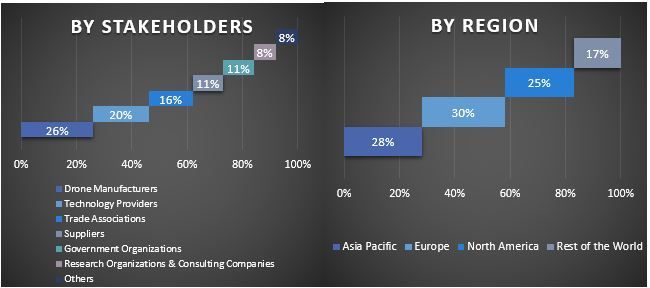
Ingeniería de Mercado
Se empleó la técnica de triangulación de datos para completar la estimación general del mercado y llegar a cifras estadísticas precisas para cada segmento y subsegmento del mercado global de guerra con drones. Los datos se dividieron en varios segmentos y subsegmentos después de estudiar varios parámetros y tendencias en las áreas de la capacidad, el modo de transporte y la aplicación en el mercado global de guerra con drones.
El objetivo principal del Estudio del Mercado Global de Guerra con Drones
Las tendencias actuales y futuras del mercado global de guerra con drones se identificaron en el estudio. Los inversores pueden obtener información estratégica para basar su discreción para las inversiones en el análisis cualitativo y cuantitativo realizado en el estudio. Las tendencias actuales y futuras del mercado determinaron el atractivo general del mercado a nivel regional, proporcionando una plataforma para que el participante industrial explote el mercado sin explotar para beneficiarse de una ventaja de primer movimiento. Otros objetivos cuantitativos de los estudios incluyen:
- Analizar el tamaño actual y pronosticado del mercado de guerra con drones en términos de valor (USD). Además, analizar el tamaño actual y pronosticado del mercado de diferentes segmentos y subsegmentos.
- Los segmentos en el estudio incluyen áreas de capacidad, modo de transporte y aplicación.
- Definición y análisis del marco regulatorio para la guerra con drones
- Analizar la cadena de valor involucrada con la presencia de varios intermediarios, junto con el análisis de los comportamientos de los clientes y los competidores de la industria.
- Analizar el tamaño actual y pronosticado del mercado de guerra con drones para la región principal.
- Los principales países de las regiones estudiadas en el informe incluyen Asia Pacífico, Europa, América del Norte y el Resto del Mundo
- Perfiles de empresas del mercado de guerra con drones y las estrategias de crecimiento adoptadas por los actores del mercado para mantenerse en el mercado de rápido crecimiento.
- Análisis a nivel regional en profundidad de la industria
Preguntas frecuentes Preguntas frecuentes
P1: ¿Cuál es el tamaño actual del mercado y el potencial de crecimiento del mercado de guerra con drones?
P2: ¿Cuáles son los factores impulsores del crecimiento del mercado de guerra con drones?
P3: ¿Qué segmento tiene la mayor cuota de mercado de guerra con drones por Capacidad?
P4: ¿Cuáles son las tecnologías y tendencias emergentes en el mercado de guerra con drones?
P5: ¿Qué región dominará el mercado de guerra con drones?
Relacionados Informes
Los clientes que compraron este artículo también compraron


